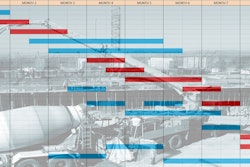
Artificial intelligence technology that can produce various types of content including text, imagery, audio and synthetic data – generative AI – has taken the world by storm with the recent rollout of OpenAI’s language model, GPT-4. The technology can compose new content, converse with humans and seemingly display incredible creativity, and even emotion. Some AI experts and tech leaders have called for a ban on the development of AI, saying it’s moving too fast for its risks to properly be studied.
Whether you find generative AI exciting or scary (or maybe a bit of both), AI has already optimized construction contracts, with tools that can “read” a contract document, flag deviations from a company’s standard contracts, and suggest edits that are in-line with provisions that have been used before. Some companies are realizing incredible efficiencies in contract review and negotiation using these AI-based tools.
Generative AI is the next frontier. This piece will discuss some of the top applications for large language models and generative AI in construction contracts – as well as some of the challenges to adopting this incredible new technology.
Applications of Generative AI in Construction Contracts
What can generative AI do that will be useful in construction contracts?
1. Plain English Summaries. Generative AI can be used to turn the "legalese” of contracts into plain language. This could be leveraged in construction in several ways, including helping project managers, superintendents and other field personnel understand what the contract means during contract execution. Construction contracts are active documents that are constantly being referenced, interpreted and revised as a project gets built. Generative AI can help ensure those responsible for performing the contract and overseeing the project can understand its requirements by translating dense language into plain English.
2. Drafting. Generative AI also can draft brand new contracts, and it will continue to get better at this task over time. In the future, rather than relying on template contracts from the AIA or Law Insider, generative AI will be able to respond to users’ inputs and specifications and draft contracts that reflect their bargaining position and business goals. Ideally, template contract offerings will increasingly integrate generative AI to better customize contracts, incorporating specific considerations for each type of project.
3. Data Extraction. With construction enterprises having a revolving set of contracts in various stages of proposal, negotiation and execution, keeping track of delivery deadlines, payments and expiration dates is a challenge. Generative AI performs well at extracting key data from large volumes of text like contract sets – this key data can then be automatically inputted into other systems such as accounting and billing, or automatically trigger notice processes or initiative renewals. In a low-margin business like construction, reducing administrative time around legal tasks and executing contract requirements means more time to focus on revenue-generation.
4. Prompt-Based Editing. The contract negotiation process typically involves many edits and changes exchanged between the parties. Generative AI can help implement requested revisions across a document, removing the manual work – and the possibility for error – making all changes consistent and uniform. An example of how this might work in practice: a construction enterprise could use AI to automatically redline contracts to change the governing law to New York. Advanced AI can also flag to contract reviewers when a clause looks similar to where they’ve made a change and prompt whether the user would like to make that change again.
Hurdles for Tech Advancement and Adoption
There’s no question that new technologies, including generative AI, have the potential to transform all industries, including construction.
Generative AI is simplifying processes like contract review, removing the complexity and inefficiency associated with negotiating an agreement. In contract review and negotiation, redlining sentences as opposed to replacing whole paragraphs is much more difficult from a text recognition and technology perspective. Generative AI is enabling leaps in terms of not only point edits to contracts, but in terms of technology that seems to understand and recognize meaning in legal language.
But there are a number of potential hurdles to users tapping AI’s full potential.
Because enterprises must use an outside vendor or integrate technology to apply generative AI to their data, information security is a big concern. A recent poll by Gartner found that nearly half of firms are drafting policies on use of ChatGPT, and some companies have banned it, mainly due to information security concerns. These issues are likely to be resolved within the next year as technology providers beef up their information security and generative AI is increasingly interwoven with existing tools used for construction contracts that already maintain robust security protocols.
Another barrier to generative AI adoption may be more difficult to overcome: getting people to actually use it. Despite its promise of creating greater efficiency and accuracy, reducing contract risk and freeing up valuable employee time, there is currently a trust deficit with leveraging AI. For efficiencies to be realized, users must have enough trust in the technology that they won’t have to manually repeat the work to check everything it has produced. In its current iteration, the fact that generative AI can “hallucinate” – that is, produce confident responses that aren’t true or justified by the training data – discourages the trust needed for more widespread adoption of this tech.
Going forward, those aiming to make contracting more efficient through AI must focus on giving users context and control. Context is important for helping those negotiating and managing contracts insight into what’s in the “black box” of AI. Tools that not only suggest helpful changes to a contract but explain why they have done so – based on a company’s playbook or past changes that are similar – will be key to promoting AI adoption.
Similarly, it is crucial that users are in control of their AI. Construction contract reviewers and negotiators are responding to quickly changing site and market conditions. Having insight into their contract technology’s rules and algorithms is important – so is the ability to override them if the project calls for it.


















